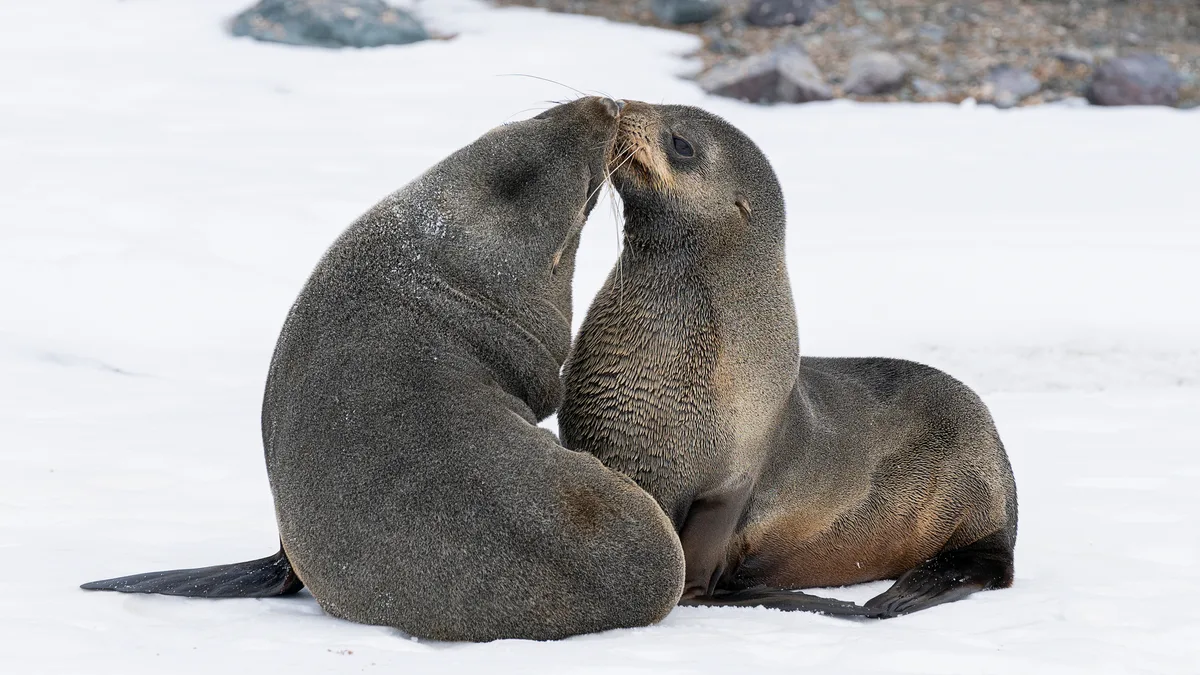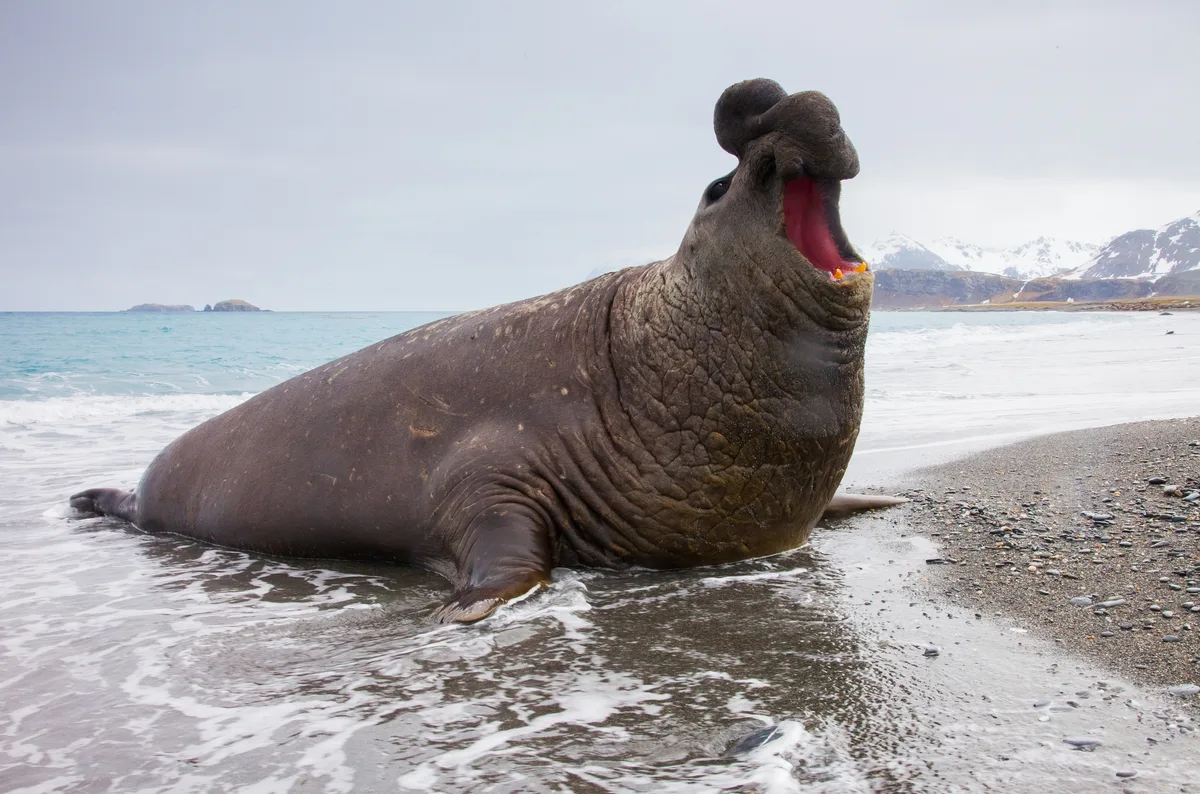Antarctica is the southernmost, coldest continent and the only one with no permanent human habitation. With most of its surface covered in ice, it’s a tough wilderness to survive in. But incredibly, some of the world’s most captivating species thrive.
Early in spring 2025, scientists caught the first-ever footage of the incredible glacial glass squid (Galiteuthis glacialis). It was first sighted in January 2025, and goes to show how we’re still discovering the incredible species that survive in one of the most hostile environments on earth.
From other magnificent deep-sea dwellers to playful penguins and captivating birds, we take a look at the most iconic animals that have evolved to withstand the region’s freezing temperatures and months of darkness.
Antarctic animals
Emperor penguin
 Emperor penguins and chicks at Snow Hill Island, Antartic Peninsula. Getty Images
Emperor penguins and chicks at Snow Hill Island, Antartic Peninsula. Getty Images
The emperor penguin (Aptenodytes forsteri) is Antarctica’s largest and most iconic bird. Standing at around 1.2m tall, it’s the only penguin species that breeds during the continent’s brutal winter. The birds huddle in massive colonies to protect their young from temperatures as low as -55°C.
The adults have several dense layers of waterproof feathers for insulation and their beaks and flippers are small, to reduce heat loss. Typically, emperors spend the first months of the year (January to March) feeding at sea to build up fat reserves for the winter.
Read more
Antarctic fur seal
 Two young Antarctic fur seals play fighting. Getty Images
Two young Antarctic fur seals play fighting. Getty Images
Once on the verge of extinction due to intensive hunting, the Antarctic fur seal has made an incredible comeback. Today, millions thrive in the icy waters surrounding Antarctica. They are fast movers and can reach speeds of up to 20kph on land and even quicker in the water. They are named after their thick fur, the reason they were hunted in the 19th century. The dense fur and layer of blubber insulate them against the freezing temperatures.
Southern elephant seal
 The ginormous southern elephant seal. Getty Images
The ginormous southern elephant seal. Getty Images
The southern elephant seal (Mirounga leonina) is the largest seal species, with adult males weighing in at up to a whopping 4,000kg. They can also grow to a huge 6m in length. They are loud, too – mature males have a large proboscis (nose), which is used to amplify its vocalisations – a series of burps and belches, clicks and snorts.
The southern elephant seals breed in dense colonies on subantarctic islands, such as the island of South Georgia, where over half of the world’s population congregates. They are powerful swimmers and can hold their breath for up to two hours as they search for squid and deep-sea fish.
Weddell seal
Huge kudos to the only mammal tough enough to live this far south in the Antarctic all year round. It can grow up to 3m long and weighs up to 500g. Named after the British sailor and navigator James Weddell, the Weddell seal (Leptonychotes weddellii) spends great lengths of time under the sea ice.
They can survive up to an hour in the icy water before needing air. They use razor-sharp protruding teeth to scrape away ice to keep freezing holes open.
Blue whale
 Antarctic blue whale numbers are recovering. Getty Images
Antarctic blue whale numbers are recovering. Getty Images
The Antarctic seals may be big, but this marine mammal beats it hands down. The largest mammal ever to have existed, the female blue whale (Balaenoptera musculus) weighs a mega 190,000kg – that’s significantly more than the male, which tips the scales to 150,000kg. During the main feeding season, they’ll consume 3600kg of krill per day.
Adélie penguin
Adélie penguins (Pygoscelis adeliae) are endemic to Antarctica, and it’s the only place you’ll find them in the polar regions. They are reasonably smaller than emperor penguins, standing at around 70cm, and not quite as hardy. While they have similar heat exchange blood systems in their flippers and legs to reduce heat loss, their breeding season is in summer and they’ll move to rocky coastlines and ice-free breeding sites rather than marching inland as the emperors do.
Antarctic petrel
 The Antarctic petrel roosts on icebergs. Getty Images
The Antarctic petrel roosts on icebergs. Getty Images
Several species of petrel choose Antarctica as their home, including the Antarctic petrel (Thalassoica antarctica). It’s identified by its chocolate–brown and white wings and white tail with brown tip. They are sociable birds and roost on icebergs in flocks that can feature thousands of birds. Breeding colonies can have more than 200,000 pairs.
The snow petrel, an all-white bird, breeds exclusively in Antarctica too. They eat krill, fish and small squid, and can dive from the air or the surface of the water.
South Polar skua
 A South Polar skua waiting to scavenge penguin meat from a recent kill by a leopard seal. Getty Images
A South Polar skua waiting to scavenge penguin meat from a recent kill by a leopard seal. Getty Images
This bold and powerful seabird breeds on the Antarctic continent, usually on ice-free coastal areas, laying their eggs in shallow nests. They fiercely defend their nests from predators and are ferocious when hunting for prey to feed their young.
The South Polar skua (Stercorarius maccormicki) often steals food from other seabirds or raids penguin nests to feed on eggs and chicks, especially the Adélie penguin. Come winter, it migrates huge distances, to the north in both Atlantic and Pacific regions.
Antarctic toothfish
These large, slender fish with broad heads are known for being the hardiest in the sea – able to withstand waters of between -1.5°C and 1.3°C. As the Antarctic toothfish (Dissostichus mawsoni) lives in temperatures lower than at which water freezes, it produces antifreeze glycoproteins to stop its blood freezing. It also eats huge amounts, warming itself up as it digests. It can be found up to depths of 2.2km.
Antarctic krill
 Antarctic krill are a key species in the local ecosystem. Getty Images
Antarctic krill are a key species in the local ecosystem. Getty Images
This tiny swimming crustacean is one of five species of krill that lives in the Southern Ocean. Adults can weigh up to 1g, but despite their minute size they are crucial for the ocean’s food chain. The Antarctic krill (Euphausia superba) gather in vast swarms and act as food for everything from whales and seals to penguins and seabirds. Despite the fact they can survive for more than 200 days of starvation, they are facing significant threats from climate change impacts.
More fascinating facts about Antarctica
Main image: Weddell seal, Getty Images
